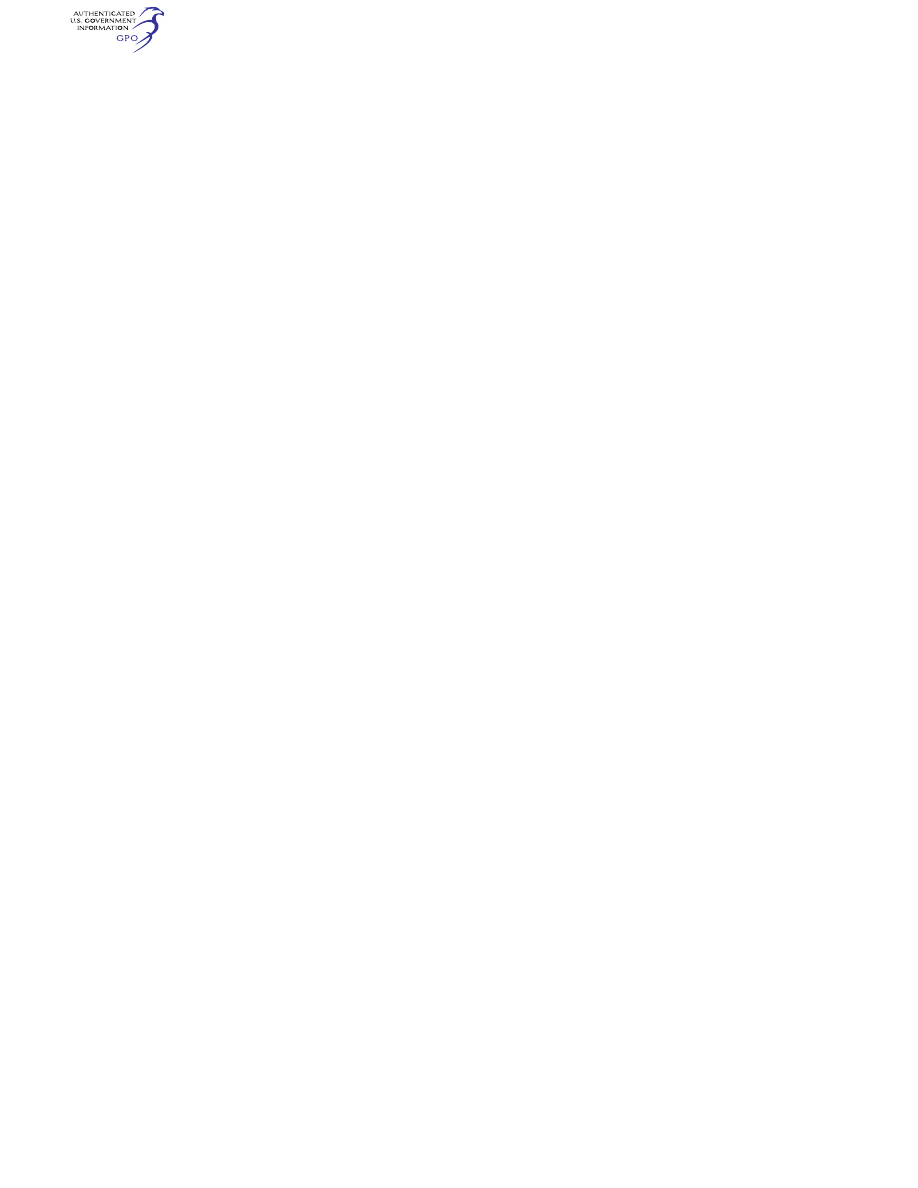
623
Federal Aviation Administration, DOT
§ 29.865
(h)
Heater fuel systems. Each heater
fuel system must meet the powerplant
fuel system requirements affecting safe
heater operation. Each heater fuel sys-
tem component in the ventilating air-
stream must be protected by shrouds
so that no leakage from those compo-
nents can enter the ventilating air-
stream.
(i)
Drains. There must be means for
safe drainage of any fuel that might ac-
cumulate in the combustion chamber
or the heat exchanger. In addition—
(1) Each part of any drain that oper-
ates at high temperatures must be pro-
tected in the same manner as heater
exhausts; and
(2) Each drain must be protected
against hazardous ice accumulation
under any operating condition.
[Doc. No. 5084, 29 FR 16150, Dec. 3, 1964, as
amended by Amdt. 29–2, 32 FR 6914, May 5,
1967]
§ 29.861
Fire protection of structure,
controls, and other parts.
Each part of the structure, controls,
and the rotor mechanism, and other
parts essential to controlled landing
and (for category A) flight that would
be affected by powerplant fires must be
isolated under § 29.1191, or must be—
(a) For category A rotorcraft, fire-
proof; and
(b) For Category B rotorcraft, fire-
proof or protected so that they can per-
form their essential functions for at
least 5 minutes under any foreseeable
powerplant fire conditions.
[Doc. No. 5084, 29 FR 16150, Dec. 3, 1964, as
amended by Amdt. 27–26, 55 FR 8005, Mar. 6,
1990]
§ 29.863
Flammable fluid fire protec-
tion.
(a) In each area where flammable
fluids or vapors might escape by leak-
age of a fluid system, there must be
means to minimize the probability of
ignition of the fluids and vapors, and
the resultant hazards if ignition does
occur.
(b) Compliance with paragraph (a) of
this section must be shown by analysis
or tests, and the following factors must
be considered:
(1) Possible sources and paths of fluid
leakage, and means of detecting leak-
age.
(2) Flammability characteristics of
fluids, including effects of any combus-
tible or absorbing materials.
(3) Possible ignition sources, includ-
ing electrical faults, overheating of
equipment, and malfunctioning of pro-
tective devices.
(4) Means available for controlling or
extinguishing a fire, such as stopping
flow of fluids, shutting down equip-
ment, fireproof containment, or use of
extinguishing agents.
(5) Ability of rotorcraft components
that are critical to safety of flight to
withstand fire and heat.
(c) If action by the flight crew is re-
quired to prevent or counteract a fluid
fire (e.g. equipment shutdown or actu-
ation of a fire extinguisher), quick act-
ing means must be provided to alert
the crew.
(d) Each area where flammable fluids
or vapors might escape by leakage of a
fluid system must be identified and de-
fined.
(Secs. 313(a), 601, 603, 604, Federal Aviation
Act of 1958 (49 U.S.C. 1354(a), 1421, 1423, 1424),
sec. 6(c), Dept. of Transportation Act (49
U.S.C. 1655(c)))
[Amdt. 29–17, 43 FR 50600, Oct. 30, 1978]
E
XTERNAL
L
OADS
§ 29.865
External loads.
(a) It must be shown by analysis,
test, or both, that the rotorcraft exter-
nal load attaching means for rotor-
craft-load combinations to be used for
nonhuman external cargo applications
can withstand a limit static load equal
to 2.5, or some lower load factor ap-
proved under §§ 29.337 through 29.341,
multiplied by the maximum external
load for which authorization is re-
quested. It must be shown by analysis,
test, or both that the rotorcraft exter-
nal load attaching means and cor-
responding personnel carrying device
system for rotorcraft-load combina-
tions to be used for human external
cargo applications can withstand a
limit static load equal to 3.5 or some
lower load factor, not less than 2.5, ap-
proved under §§ 29.337 through 29.341,
multiplied by the maximum external
load for which authorization is re-
quested. The load for any rotorcraft-
load combination class, for any exter-
nal cargo type, must be applied in the
VerDate Sep<11>2014
09:06 Jun 28, 2024
Jkt 262046
PO 00000
Frm 00633
Fmt 8010
Sfmt 8010
Y:\SGML\262046.XXX
262046
jspears on DSK121TN23PROD with CFR

624
14 CFR Ch. I (1–1–24 Edition)
§ 29.865
vertical direction. For jettisonable ex-
ternal loads of any applicable external
cargo type, the load must also be ap-
plied in any direction making the max-
imum angle with the vertical that can
be achieved in service but not less than
30
°
. However, the 30
°
angle may be re-
duced to a lesser angle if—
(1) An operating limitation is estab-
lished limiting external load oper-
ations to such angles for which compli-
ance with this paragraph has been
shown; or
(2) It is shown that the lesser angle
can not be exceeded in service.
(b) The external load attaching
means, for jettisonable rotorcraft-load
combinations, must include a quick-re-
lease system to enable the pilot to re-
lease the external load quickly during
flight. The quick-release system must
consist of a primary quick release sub-
system and a backup quick release sub-
system that are isolated from one an-
other. The quick release system, and
the means by which it is controlled,
must comply with the following:
(1) A control for the primary quick
release subsystem must be installed ei-
ther on one of the pilot’s primary con-
trols or in an equivalently accessible
location and must be designed and lo-
cated so that it may be operated by ei-
ther the pilot or a crewmember with-
out hazardously limiting the ability to
control the rotorcraft during an emer-
gency situation.
(2) A control for the backup quick re-
lease subsystem, readily accessible to
either the pilot or another crew-
member, must be provided.
(3) Both the primary and backup
quick release subsystems must—
(i) Be reliable, durable, and function
properly with all external loads up to
and including the maximum external
limit load for which authorization is
requested.
(ii) Be protected against electro-
magnetic interference (EMI) from ex-
ternal and internal sources and against
lightning to prevent inadvertent load
release.
(A) The minimum level of protection
required for jettisonable rotorcraft-
load combinations used for nonhuman
external cargo is a radio frequency
field strength of 20 volts per meter.
(B) The minimum level of protection
required for jettisonable rotorcraft-
load combinations used for human ex-
ternal cargo is a radio frequency field
strength of 200 volts per meter.
(iii) Be protected against any failure
that could be induced by a failure mode
of any other electrical or mechanical
rotorcraft system.
(c) For rotorcraft-load combinations
to be used for human external cargo
applications, the rotorcraft must—
(1) For jettisonable external loads,
have a quick-release system that meets
the requirements of paragraph (b) of
this section and that—
(i) Provides a dual actuation device
for the primary quick release sub-
system, and
(ii) Provides a separate dual actu-
ation device for the backup quick re-
lease subsystem;
(2) Have a reliable, approved per-
sonnel carrying device system that has
the structural capability and personnel
safety features essential for external
occupant safety;
(3) Have placards and markings at all
appropriate locations that clearly state
the essential system operating instruc-
tions and, for the personnel carrying
device system, ingress and egress in-
structions;
(4) Have equipment to allow direct
intercommunication among required
crewmembers and external occupants;
(5) Have the appropriate limitations
and procedures incorporated in the
flight manual for conducting human
external cargo operations; and
(6) For human external cargo applica-
tions requiring use of Category A
rotorcraft, have one-engine-inoperative
hover performance data and procedures
in the flight manual for the weights,
altitudes, and temperatures for which
external load approval is requested.
(d) The critically configured jettison-
able external loads must be shown by a
combination of analysis, ground tests,
and flight tests to be both transport-
able and releasable throughout the ap-
proved operational envelope without
hazard to the rotorcraft during normal
flight conditions. In addition, these ex-
ternal loads—must be shown to be re-
leasable without hazard to the rotor-
craft during emergency flight condi-
tions.
VerDate Sep<11>2014
09:06 Jun 28, 2024
Jkt 262046
PO 00000
Frm 00634
Fmt 8010
Sfmt 8010
Y:\SGML\262046.XXX
262046
jspears on DSK121TN23PROD with CFR

625
Federal Aviation Administration, DOT
§ 29.903
(e) A placard or marking must be in-
stalled next to the external-load at-
taching means clearly stating any
operational limitations and the max-
imum authorized external load as dem-
onstrated under § 29.25 and this section.
(f) The fatigue evaluation of § 29.571
of this part does not apply to rotor-
craft-load combinations to be used for
nonhuman external cargo except for
the failure of critical structural ele-
ments that would result in a hazard to
the rotorcraft. For rotorcraft-load
combinations to be used for human ex-
ternal cargo, the fatigue evaluation of
§ 29.571 of this part applies to the entire
quick release and personnel carrying
device structural systems and their at-
tachments.
[Amdt. 29–12, 41 FR 55472, Dec. 20, 1976, as
amended by Amdt. 27–26, 55 FR 8005, Mar. 6,
1990; Amdt. 29–43, 64 FR 43020, Aug. 6, 1999]
M
ISCELLANEOUS
§ 29.871
Leveling marks.
There must be reference marks for
leveling the rotorcraft on the ground.
§ 29.873
Ballast provisions.
Ballast provisions must be designed
and constructed to prevent inadvertent
shifting of ballast in flight.
Subpart E—Powerplant
G
ENERAL
§ 29.901
Installation.
(a) For the purpose of this part, the
powerplant installation includes each
part of the rotorcraft (other than the
main and auxiliary rotor structures)
that—
(1) Is necessary for propulsion;
(2) Affects the control of the major
propulsive units; or
(3) Affects the safety of the major
propulsive units between normal in-
spections or overhauls.
(b) For each powerplant installa-
tion—
(1) The installation must comply
with—
(i) The installation instructions pro-
vided under § 33.5 of this chapter; and
(ii) The applicable provisions of this
subpart.
(2) Each component of the installa-
tion must be constructed, arranged,
and installed to ensure its continued
safe operation between normal inspec-
tions or overhauls for the range of tem-
perature and altitude for which ap-
proval is requested.
(3) Accessibility must be provided to
allow any inspection and maintenance
necessary for continued airworthiness;
and
(4) Electrical interconnections must
be provided to prevent differences of
potential between major components of
the installation and the rest of the
rotorcraft.
(5) Axial and radial expansion of tur-
bine engines may not affect the safety
of the installation.
(6) Design precautions must be taken
to minimize the possibility of incorrect
assembly of components and equipment
essential to safe operation of the rotor-
craft, except where operation with the
incorrect assembly can be shown to be
extremely improbable.
(c) For each powerplant and auxiliary
power unit installation, it must be es-
tablished that no single failure or mal-
function or probable combination of
failures will jeopardize the safe oper-
ation of the rotorcraft except that the
failure of structural elements need not
be considered if the probability of any
such failure is extremely remote.
(d) Each auxiliary power unit instal-
lation must meet the applicable provi-
sions of this subpart.
(Secs. 313(a), 601, 603, 604, Federal Aviation
Act of 1958 (49 U.S.C. 1354(a), 1421, 1423, 1424),
sec. 6(c), Dept. of Transportation Act (49
U.S.C. 1655(c)))
[Doc. No. 5084, 29 FR 16150, Dec. 3, 1964, as
amended by Amdt. 29–3, 33 FR 969, Jan. 26,
1968; Amdt. 29–13, 42 FR 15046, Mar. 17, 1977;
Amdt. 29–17, 43 FR 50600, Oct. 30, 1978; Amdt.
29–26, 53 FR 34215, Sept. 2, 1988; Amdt. 29–36,
60 FR 55776, Nov. 2, 1995]
§ 29.903
Engines.
(a)
Engine type certification. Each en-
gine must have an approved type cer-
tificate. Reciprocating engines for use
in helicopters must be qualified in ac-
cordance with § 33.49(d) of this chapter
or be otherwise approved for the in-
tended usage.
VerDate Sep<11>2014
09:06 Jun 28, 2024
Jkt 262046
PO 00000
Frm 00635
Fmt 8010
Sfmt 8010
Y:\SGML\262046.XXX
262046
jspears on DSK121TN23PROD with CFR


